
Millipedes are a group of arthropods that are characterised by having two pairs of jointed legs on most body segments; they are known scientifically as the class Diplopoda, the name derived from this feature. Each double-legged segment is a result of two single segments fused together. Most millipedes have very elongated cylindrical or flattened bodies with more than 20 segments, while pill millipedes are shorter and can roll into a tight ball. Although the name "millipede" derives from Latin for "thousand feet", no species was known to have 1,000 or more until the discovery in 2020 of Eumillipes persephone, which can have over 1,300 legs. There are approximately 12,000 named species classified into 16 orders and around 140 families, making Diplopoda the largest class of myriapods, an arthropod group which also includes centipedes and other multi-legged creatures.
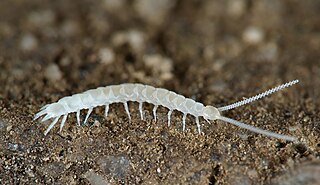
Symphylans, also known as garden centipedes or pseudocentipedes, are soil-dwelling arthropods of the class Symphyla in the subphylum Myriapoda. Symphylans resemble centipedes, but are very small, non-venomous, and only distantly related to both centipedes and millipedes. They can move rapidly through the pores between soil particles, and are typically found from the surface down to a depth of about 50 centimetres (20 in). They consume decaying vegetation, but can do considerable harm in an agricultural setting by consuming seeds, roots, and root hairs in cultivated soil.
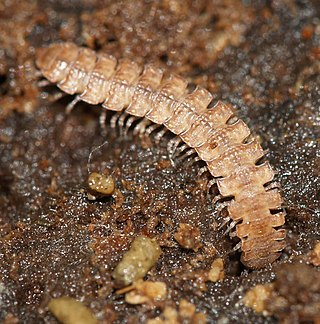
Chilognatha is a subclass of the class Diplopoda, which includes the vast majority of extant millipedes, about 12,000 species.
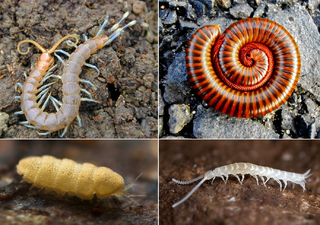
Myriapods are the members of subphylum Myriapoda, containing arthropods such as millipedes and centipedes. The group contains about 13,000 species, all of them terrestrial.

Spirobolida is an order of "round-backed" millipedes containing approximately 500 species in 12 families. Its members are distinguished by the presence of a "pronounced suture that runs "vertically down the front of the head". Most of the species live in the tropics, and many are brightly coloured. Mature males have two pairs of modified legs, the gonopods, consisting of the 8th and 9th leg pair: the posterior gonopods are used in sperm-transfer while the anterior gonopods are fused into a single plate-like structure.

Glomerida is an order of pill-millipedes found primarily in the Northern Hemisphere. Also known as northern pill millipedes, they superficially resemble pill-bugs or woodlice, and can enroll into a protective ball. They have twelve body segments, 17 to 19 pairs of legs, and males have enlarged rear legs involved in mating. The order includes about 30 genera and at least 280 species, including Glomeris marginata, the common European pill-millipede. The order contains members in Europe, South-east Asia and the Americas from California to Guatemala. Although historically considered closely related with the similar sphaerotheriidans that also enroll, some DNA evidence suggest they may be more closely related to glomeridesmidans, a poorly known order that does not enroll.

Spirostreptida is an order of long, cylindrical millipedes. There are approximately 1000 described species, making Spirostreptida the third largest order of millipedes after Polydesmida and Chordeumatida.

Julida is an order of millipedes. Members are mostly small and cylindrical, typically ranging from 10–120 millimetres (0.39–4.72 in) in length. Eyes may be present or absent, and in mature males of many species, the first pair of legs is modified into hook-like structures. Additionally, both pairs of legs on the 7th body segment of males are modified into gonopods.
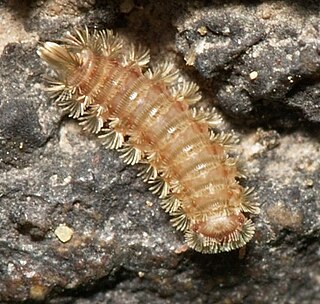
Polyxenida is an order of millipedes readily distinguished by a unique body plan consisting of a soft, non-calcified body ornamented with tufts of bristles – traits that have inspired the common names "bristly millipedes" or "pincushion millipedes". There are at least 86 species in four families worldwide, and are the only living members of the subclass Penicillata.

Glomeridesmida is an order of millipedes in the infraclass Pentazonia containing 2 families and at least 31 species. Glomeridesmida is the only living order of the superorder Limacomorpha. Also known as slug millipedes, glomeridesmidans are small and somewhat flattened, and unlike other orders of Pentazonia, are unable to roll into a ball. Ocelli (eyes) are absent.

Callipodida is an order of millipedes containing around 130 species, many characterized by crests or ridges.

Dalodesmidae is a family of millipedes in the order Polydesmida, containing at least 250 species found in the Southern Hemisphere.

Colobognatha is a clade of helminthomorph millipedes containing four orders: Platydesmida, Polyzoniida, Siphonocryptida, and Siphonophorida.

Chordeumatida is a large order of millipedes containing some 1200 species with a nearly worldwide distribution. Also known as sausage millipedes, they grow and develop through a series of moults, adding segments until they reach a fixed number in the adult stage, which is usually the same for a given sex in a given species, at which point the moulting and the addition of segments and legs stop. This mode of development, known as teloanamorphosis, distinguishes this order from most other orders of millipedes, which usually continue to moult as adults, developing through either euanamorphosis or hemianamorphosis.

Siphoniulus is a poorly known genus of millipede containing only two living species: S. alba from Indonesia, and S. neotropicus from Mexico and Guatemala. An additional two fossil species are known from Cretaceous amber. Siphoniulus species are the only members of the family Siphoniulidae and order Siphoniulida, making Siphoniulida the smallest millipede order. Few specimens are known, and their classification is contentious, although most recent studies place them as basal members of the Helminthomorpha.

Stemmiulida is an order of millipedes consisting of approximately 130 species, reaching up to 50 mm in length. It contains a single family, Stemmiulidae.

Andrognathidae is a family of millipede in the order Platydesmida. There are about 17 genera and more than 30 described species in Andrognathidae.
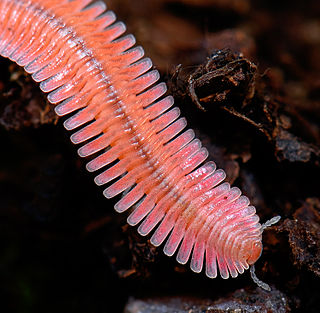
Brachycybe (Greek for "short head") is a genus of andrognathid millipedes with species in the United States and East Asia. In a rare example of paternal care in invertebrates, males of most species guard the eggs until they hatch.

Gosodesmus is a genus of platydesmidan millipede, described by Ralph V. Chamberlin in 1922, that is widely distributed in the U.S. state of California. It is monotypic, being represented by the single species, Gosodesmus claremontus, commonly known as the pink feather boa millipede. Individuals vary in color from bright pink to coral, and may possess a black or purple dorsal stripe. Body length ranges from 17 to 27 mm, with up to 81 body segments. Gosodesmus claremontus occurs on the Coast Ranges as well as the Sierra Nevada, and is often found within rotted wood, especially oaks. In 2020, chemist Dr. Tappey Jones at Virginia Military Institute and colleagues, discovered a novel natural product and alkaloid in the chemical defense secretion of G. claremontus: (1), 7-(4-methylpent-3-en-1-yl)-1,2,3,5,8,8a-hexahydroindolizine, known as gosodesmine.
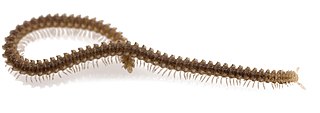
Andrognathus is a genus of North American millipedes in the family Andrognathidae, containing three species: A. corticarius, A. grubbsi, and A. hoffmani. The fossil species Andrognathus burmiticus is known from approximately 99 million year old Burmese amber from Myanmar, showing that the genus had a much wider distribution in the past.
























